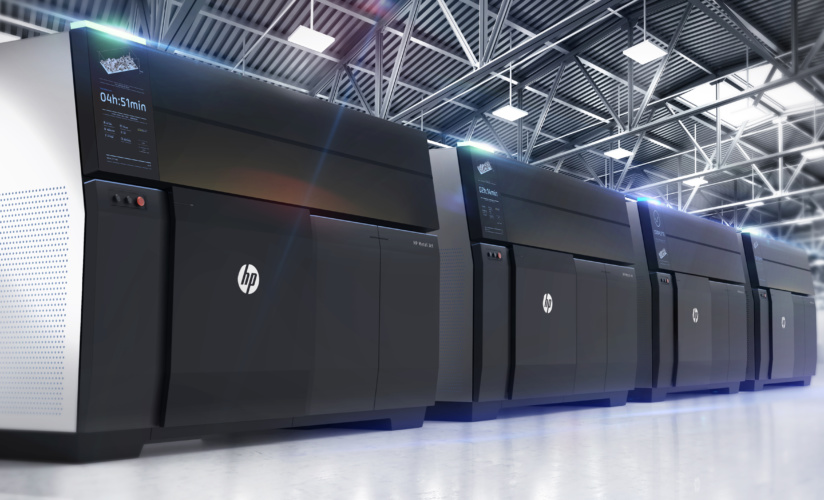Meet the panel
- Philipp Jung (PJ) - GM and global head, Vertical Industries & End-to-End Applications, 3D Printing & Digital Manufacturing, HP Inc
- Scott Turner (ST) - director, Advanced R&D, 3D Systems
- Amos Breyfogle (AB) - senior application engineer, Stratasys
What are the most exciting trends in additive at the moment?
PJ: Advanced 3D printing is accelerating the shift to digital manufacturing as customers make significant strides on their journey to mass production. And the industry is embracing a new design mindset, as entire organisations realise time, quality and economic advantages. It’s about changing how the world designs for manufacturing.

ST: The most exciting developments right now are in additive materials. The key to better and more reliable additive parts is not just from improvements in the technologies themselves, but in materials that really correspond to the needs of manufacturers for end-use part production. This trend has been occurring rapidly for a few years now and you can see 3D printed parts that really hit the mark in terms of toughness, rigidity, and extended use. New materials that stand up to high heat and extreme environments are maturing rapidly, making additive a reality for yet more production-grade parts.
AB:Perhaps one of the most interesting trends is the impact of additive manufacturing on supply chain issues. We’ve seen more and more companies turn to additive manufacturing because it offers true ‘on-demand’ production, close to the point of consumption. For manufacturers, this is a game-changer, with missing or broken parts produced in only a few hours. In aerospace, this can overhaul the traditional maintenance, repair and operations supply chain. Our customer Airbus is a great example. To meet the production delivery deadlines of its A350 XWB aircraft, the company leveraged our FDM technology to manufacture over 1000 parts that are flying today.
How is the technology being adopted across different sectors?
 ST: For every sector, adoption of additive starts with a single success that forms the confidence to trust AM for their products. For almost every industry, AM has become the “best practice” for prototyping efforts. These prototypes are often the genesis of how a company suddenly sees the path forward to use additive for better performance and get to market faster than ever before. All sectors are in a race to achieve that success and new materials for additive enable that. The technology has so many strengths in complexity and speed in which things can be made, I believe it will become the dominant manufacturing method for many industries.
ST: For every sector, adoption of additive starts with a single success that forms the confidence to trust AM for their products. For almost every industry, AM has become the “best practice” for prototyping efforts. These prototypes are often the genesis of how a company suddenly sees the path forward to use additive for better performance and get to market faster than ever before. All sectors are in a race to achieve that success and new materials for additive enable that. The technology has so many strengths in complexity and speed in which things can be made, I believe it will become the dominant manufacturing method for many industries.
AB: If we take the manufacturing industry – aerospace, automotive and mobility are key vertical sectors that fall within it and which demonstrate the end-to-end way in which 3D printing/additive manufacturing is being deployed. For example, in each of these sectors, design engineers will be accessing technologies such as PolyJet to conceptualise and develop ultra-realistic functional prototype models. The production lines of these same companies will likely be harnessing other, more industrial-based technologies, such as FDM, and via durable thermoplastics be producing production-line tooling such as jigs & fixtures. The same technology could then be deployed to produce low-volume production parts that adhere to specific industry-standards and that ultimately are used in cars, trains and aircraft.
PJ: HP is embracing an end-to-end applications approach, focusing our 3D printing efforts on four key verticals—automotive, footwear, dental and medical. As part of that, HP is offering advanced 3D printing solutions to help customers in these key markets develop breakthrough applications, speed time to market and accelerate their journey to digital manufacturing. In the automotive sector, HP is working with some giants including Volkswagen, BMW and Jaguar Land Rover. And in footwear, HP’s 3D printing technology powers the FitStation platform for the production of customised 3D printed insoles.
Can you give us an interesting customer success story?
 PJ: I am really excited about SmileDirectClub, the pioneer of teledentistry and market leader in doctor-directed, remote clear aligner therapy, and how HP is powering their extraordinary growth. SmileDirectClub is now the largest producer of Multi Jet Fusion 3D printed parts in the country, with 49 HP Jet Fusion 4210 systems running 24x7, producing more than 50,000 unique mouth moulds each day. That’s nearly 20 million custom parts in the next year alone!
PJ: I am really excited about SmileDirectClub, the pioneer of teledentistry and market leader in doctor-directed, remote clear aligner therapy, and how HP is powering their extraordinary growth. SmileDirectClub is now the largest producer of Multi Jet Fusion 3D printed parts in the country, with 49 HP Jet Fusion 4210 systems running 24x7, producing more than 50,000 unique mouth moulds each day. That’s nearly 20 million custom parts in the next year alone!
AB: A good example is our collaboration with leading train leasing company, Angel Trains; engineering consultancy, DB ESG; and train operator, Chiltern Railways. This saw us recently join forces to trial the first 3D printed parts ever deployed within an in-service passenger train in the UK. These parts include four passenger armrests and seven grab handles. Using 3D printing, Angel Trains and DB ESG were able to replace a small number of obsolete parts, producing the exact quantity they needed at a fraction of the time and cost of traditional methods.
ST: In 2015, orthopaedic device manufacturer, NuVasive, recognised the opportunity that additive delivers for production of complex and optimised parts, and how that could open new business revenues. To help design and manufacture minimally invasive spine solutions, they turned to 3D Systems. Working in collaboration, both teams pioneered a new implant line that leverages the potential of metal additive manufacturing. The result was that NuVasive went from design-to-market in just over one year with the launch of Modulus.
How do you see additive evolving in the coming years?
 AB: As is the case in many industries, digitalisation is transforming manufacturing processes. Systems development and better materials are always at the forefront of the progress in the additive manufacturing industry. We also expect software and networking to play a greater role in the coming years, helping companies decentralise production and access digital inventory on-demand. There is no doubt that the technology will get faster, cheaper and more accessible, with R&D teams across the world constantly pushing the technology to be better.
AB: As is the case in many industries, digitalisation is transforming manufacturing processes. Systems development and better materials are always at the forefront of the progress in the additive manufacturing industry. We also expect software and networking to play a greater role in the coming years, helping companies decentralise production and access digital inventory on-demand. There is no doubt that the technology will get faster, cheaper and more accessible, with R&D teams across the world constantly pushing the technology to be better.
PJ: Automated assembly will arrive, with industries seamlessly integrating multi-part assemblies including combinations of both 3D printed metal and plastic parts. The consumer health sector will fuel digital manufacturing growth and adoption, as footwear, eyewear and orthodontics applications rapidly adopt 3D printing technologies. Automakers will continue to unlock the capabilities of metal and plastic 3D printing systems to accelerate electric vehicle production. And data and software will continue to become even more important and become the true backbone of digital manufacturing.
ST: We’re entering a new era of digitally-derived products. From an industrial perspective, biomedical and aerospace applications are seeing the strongest development and honestly have not yet scratched the surface in what I think will be possible over the next decade. Research on 3D printed organs is evolving quickly. Lighter and more effective parts made by additive for airplanes, rockets and satellites are becoming real and are in flight. 3D printed ‘dentures in a day’ just received FDA certification. It’s going to be incredible to see and I’m excited to be a part of this evolution.




Nanogenerator consumes CO2 to generate electricity
Whoopee, they've solved how to keep a light on but not a lot else.